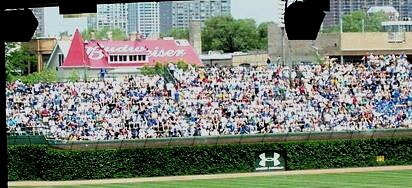How did Wrigley Field begin?
Wrigley Field has an illustrious history that dates back the year tumultuous year of 1914. This year was an infamous one because the USA joined in World War I. The establishment of Wrigley Field announced to the rest of the world, that, despite being in a terrible war, the American people were far from being hopeless.
From Weegham Park to Wrigley Field
Wrigley Field was founded in Chicago, and was originally known as Weeghman Park, named after Charlie Weeghman who founded the ballpark. Weeghman Park at first was the playing fields for the Chicago Federals. Unfortunately, the Federals went bankrupt after only playing in only two seasons resulting in Weeghman, William Wrigley, Jr. and nine others purchased the Chicago Cubs, who, at the time, were in the National League. The Cubs were moved to Weeghman Park from the West Side Grounds. Eventually William Wrigley bought out the shares that Weeghman and the nine other people held of Weeghman Park. This transaction resulted in Wrigley being the new owner of Weeghman Park. Wrigley almost immediately changed the name from Weeghman Park to Cubs Park. The grand opening of Cubs Park occurred in 1920, with the field being renamed yet again to Wrigley Field in 1926 in honor of Mr. Wrigley.
Babe Ruth’s famous “called shot”
In 1932, Babe Ruth had his legendary “called shot” against Charlie Root, a Cubs pitcher who is also known for being the last pitcher to pitch in a major league game who was born in the 1800s. Babe, allegedly, pointed out at the spot in the bleachers as if he knew he would hit it out there on the next pitch, and sure enough, the next pitch Charlie threw, Babe smashed one out onto the bleachers. After this amazing event, Charlie claimed that Babe had never even pointed out at the seats, as he saw the homer as a disgrace to his name.
Major improvements done on Wrigley Field in the 1920s-1930s
In 1927, a new upper deck was added to the stands, which allowed many more people to cram into the field, which ultimately led to more money for the staff and players of the Cubs organization. In 1937, when the Cubs organization were firmly entrenched in the baseball organization, a major change occurred to the field. The outfield area was completely renovated, with many more seats being added and the old seats being greatly improved. A scoreboard was added in addition to other major changes Wrigley field was undergoing. This scoreboard still exists today, and remains as one of the only scoreboards today that is changed by human hands and not by electricity. 1937 was also the year Wrigley field’s nationally famous vine walls were incorporated into the field walls. The vines were originally bought by a man named Bill Veeck, who held a great interest in Wrigley Field.
The renowned Wrigley Field – a legend in itself
Despite the great looks and history the field contains, it has never seen its home team, the Cubs, win the World Series Championship title. Despite the fact that Wrigley Field has hosted many World Series, including the ones in 1929, 1932, 1935, 1938, and 1945, which was the last time the Cubs have been to a World Series since.
Wrigley Field is a timeless classic baseball field. In it is history, originality, and a lot of tremendous baseball talent possessed by the Cubs organization. Wrigley field represents the American baseball world.

